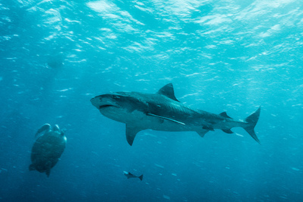Lesson summary
This lesson incorporates clips from Blue The Film as learning inspiration. Students examine and compare the respiratory systems of humans, sharks and marine turtles. They begin by working as a class to brainstorm what they already know about respiratory systems, and then investigate how human respiratory systems work. They then work in groups to investigate and compare the respiratory systems of a shark and a marine turtle and create an infographic or poster to share the results of their research. Finally students are asked to think about why having an understanding of body systems – such as respiratory systems – helps scientists to care for and protect animals.
Learning intentions:
Students can...
- understand how studying the physiology of animals can help us protect them.
Success criteria:
Students will...
- know what the respiratory system is, what the features of respiratory systems are and how respiratory systems differ between some animals
- know why we need to understand animals in order to protect them
- be able to conduct research online and from videos
- be able to annotate a scientific diagram.
Lesson guides and printables
Lesson details
Curriculum mapping
Australian curriculum content descriptions:
Year 8 Science:
- Multi-cellular organisms contain systems of organs carrying out specialised functions that enable them to survive and reproduce (ACSSU150).
Syllabus outcomes: SC4-14LW
General capabilities: Critical and creative thinking, Literacy
Cross-curriculum priority: Sustainability OI.2
Relevant parts of Year 8 Science achievement standards: Students analyse the relationship between structure and function at cell, organ and body system levels.
Unit of work: Blue The Film – Science – Year 7 & 8
Time required: 140 mins +
Level of teacher scaffolding: Medium – lead students in guided discussion.
Resources required
- Student Worksheet – one copy per student
- Device capable of presenting a website to the class
- Human Respiratory System Diagram
- Communication Piece Assessment Rubric
Skills
This lesson is designed to build students’ competencies in the following skills:
- Collaboration
- Communication
- Creativity
- Critical thinking
Additional info
Blue is a feature documentary film charting the drastic decline in the health of our oceans. With more than half of all marine life lost and the expansion of the industrialization of the seas, the film sets out the challenges we are facing and the opportunities for positive change. Blue changes the way we think about our liquid world and inspires the audience to action. Find out how to screen or download the film here. Along with the film is an ambitious global campaign to create advocacy and behaviour change through the #oceanguardian movement. To become an ocean guardian, see the website.


Welcome back!
Don't have an account yet?
Log in with:
By signing up to Cool.org you consent and agree to Cool's privacy policy to
store, manage and process your personal information. To read more, please see
our privacy policy here(Opens in new tab).
Create your free Cool.org account.
Many of our resources are free, with an option to upgrade to Cool+ for premium content.
Already have an account?
Sign up with:
By signing up to Cool.org you consent and agree to Cool's privacy policy to
store, manage and process your personal information. To read more, please see
our privacy policy here(Opens in new tab).